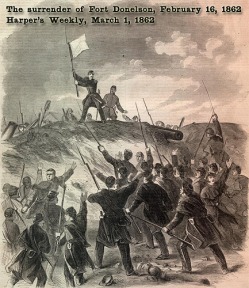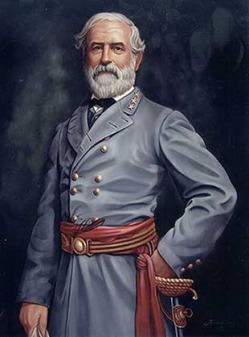The Life & Times of Ulysses S. Grant
War Between the States
Ulysses S. Grant is best known for being the commander of the Union forces in the American Civil War. When war broke out, however, he was not even a member of the armed forces! Soon after the defeat at Fort Sumter, however, Grant was offered a position to train and recruit volunteers by the governor of Illinois, which he accepted. Grant was then appointed a field command after some pressure, and became a colonel of the 21st Illinois Infantry, a regiment notorious for its unruliness. After whipping them into shape, President Lincoln appointed Grant brigadier general of militia volunteers, which the general public would recognize as a one-star general.
After this success, Grant was moved to the important District of Southeast Missouri, close to the Confederate border. His original purpose, stationed in Cairo, Illinois, (close to Southeast Missouri) was to defend and divert Confederate forces; but that did not suit the aggressive Grant. He requested and received permission to go on the offensive. Grant swept into Confederate-controlled land, and took Forts Henry and Donelson, in the first large-scale Union victory of the Civil War. At Fort Donelson, Grant fractured Confederate lines that had repulsed Union attack just the day before; it was here that he demanded "no terms except unconditional and immediate surrender." This, due to his initials, earned him the famous nickname "Unconditional Surrender" Grant.
After this success, Grant was moved to the important District of Southeast Missouri, close to the Confederate border. His original purpose, stationed in Cairo, Illinois, (close to Southeast Missouri) was to defend and divert Confederate forces; but that did not suit the aggressive Grant. He requested and received permission to go on the offensive. Grant swept into Confederate-controlled land, and took Forts Henry and Donelson, in the first large-scale Union victory of the Civil War. At Fort Donelson, Grant fractured Confederate lines that had repulsed Union attack just the day before; it was here that he demanded "no terms except unconditional and immediate surrender." This, due to his initials, earned him the famous nickname "Unconditional Surrender" Grant.
After Grant's success at Forts Henry and Donelson, Lincoln promoted him to major general (a two-star general). It was after this that Grant became a celebrity, something that would help him win the presidency in later years. In fact, after a picture was published of him smoking a cigar, fans sent him thousands of cigars---something that most likely led to his death of throat cancer at 63. Grant was given control of the Army of the Tennessee after his promotion, and moved his HQ to Savannah, Tennessee in 1862. It was in Tennessee that Grant fought the Battle of Shiloh, a surprise attack by Confederate forces on his army. Grant famously pushed off the Southern forces, but actually lost 3,000 more men than his Confederate counterpart. This heavy casualty list (13,047) shocked American citizens, and produced a large public outcry against Grant. This prompted his commanding officer to remove him from the lead position in the upcoming siege on Corinth, which nearly caused Grant to leave the Army. Luckily, William Tecumseh Sherman, a close friend and fierce general, convinced him to stay; when Grant's C.O. was called to be general-in-chief of the Union army, Grant was able to resume his position.
This left Grant free to stage the famous Siege of Vicksburg, Mississippi, the last Confederate stronghold on the Mississippi River. Grant relentlessly attacked the city, and when he won its surrender in July of 1863, he effectively cut the Confederacy in half on each side of the great river. The great victory at Vicksburg, unlike Shiloh, was accomplished with very minimal losses, and is still considered a brilliant example of military strategy. The long Vicksburg campaign cemented Lincoln's trust in Grant, and in March of 1864 the president gave Grant the rank of lieutenant general (a three-star general). Grant was the first to receive this honor since George Washington, and the post had been revived specifically for him.
Along with this promotion came overall command of all U.S. armies. The General Grant that people think of today was now a reality. He placed General William Tecumseh Sherman in control of the Western theater, and moved himself to Virginia to duel with his famous Confederate counterpart, General Robert E. Lee (pictured below).
This left Grant free to stage the famous Siege of Vicksburg, Mississippi, the last Confederate stronghold on the Mississippi River. Grant relentlessly attacked the city, and when he won its surrender in July of 1863, he effectively cut the Confederacy in half on each side of the great river. The great victory at Vicksburg, unlike Shiloh, was accomplished with very minimal losses, and is still considered a brilliant example of military strategy. The long Vicksburg campaign cemented Lincoln's trust in Grant, and in March of 1864 the president gave Grant the rank of lieutenant general (a three-star general). Grant was the first to receive this honor since George Washington, and the post had been revived specifically for him.
Along with this promotion came overall command of all U.S. armies. The General Grant that people think of today was now a reality. He placed General William Tecumseh Sherman in control of the Western theater, and moved himself to Virginia to duel with his famous Confederate counterpart, General Robert E. Lee (pictured below).
Grant vs. Lee---Battle of the Century
The main goal of the war effort was now to destroy Robert E. Lee's Army of Northern Virginia, and to cut off the Confederacy's already limited railroad network. Grant and Lincoln devised the Overland Campaign to accomplish these two goals. The main gist of this plan was to have Grant take the main force of the Army against Lee in the east and drive towards Richmond, Virginia, while Sherman made his famous March to the Sea to take Georgia; at the same time, other generals would take key strategic points and railroads to choke off Confederate supplies and men. Grant was one of the first generals to comprehend the now essential art of total war, in which a country devotes all its resources to the war effort (something already practiced in Grant's day), and also realizes that striking against your opponent's economy and infrastructure can be just as important as winning battles (something not as widely used in the mid-1800s).
The Overland Campaign began in the spring of 1864, when Grant's Army of the Potomac marched towards Lee's Army of Northern Virginia, in order to provoke an attack. It worked. Grant fought in many battles, not just a couple major ones; he knew that he had to wear Lee so thin that he wouldn't have any more men to commit to battle. Engagements were fought in Spotsylvania, Cold Harbor, and other places, and the Union almost always had higher casualty lists---but they won the battles. Grant kept on going where other generals had decided to retreat because they didn't want to incur the costs. Grant would not let himself be driven away, which was the Confederacy's main goal. They could not defeat the Union Army, but they could fend it off---until they faced Grant.
The Overland Campaign led eventually to Petersburg, Virginia. Lee was trapped in Petersburg, but would not give it up. So began the Siege of Petersburg. Trenches were dug on both sides, and the Union attempted to cut off Confederate supply lines. Sherman's Georgia campaign was doing tremendously well, and all other aspects of the war seemed to come together for the Union.After months of siege, Lee finally abandoned the city, and Richmond soon after. He retreated to Appomattox Court House, where he surrendered to Grant on April 9, 1985 (pictured below).
The Overland Campaign began in the spring of 1864, when Grant's Army of the Potomac marched towards Lee's Army of Northern Virginia, in order to provoke an attack. It worked. Grant fought in many battles, not just a couple major ones; he knew that he had to wear Lee so thin that he wouldn't have any more men to commit to battle. Engagements were fought in Spotsylvania, Cold Harbor, and other places, and the Union almost always had higher casualty lists---but they won the battles. Grant kept on going where other generals had decided to retreat because they didn't want to incur the costs. Grant would not let himself be driven away, which was the Confederacy's main goal. They could not defeat the Union Army, but they could fend it off---until they faced Grant.
The Overland Campaign led eventually to Petersburg, Virginia. Lee was trapped in Petersburg, but would not give it up. So began the Siege of Petersburg. Trenches were dug on both sides, and the Union attempted to cut off Confederate supply lines. Sherman's Georgia campaign was doing tremendously well, and all other aspects of the war seemed to come together for the Union.After months of siege, Lee finally abandoned the city, and Richmond soon after. He retreated to Appomattox Court House, where he surrendered to Grant on April 9, 1985 (pictured below).
When Lincoln was assassinated five days after Appomattox, Grant was furious. Lincoln was one of the general's best friends, and he believed that the assassination was a Southern conspiracy that needed to be punished. When he discovered that it was not a wide conspiracy, he calmed down a little. Grant had the honor of being a pallbearer at Lincoln's funeral, where he cried openly while standing at attention.
Within a few months of Lincoln's death, Congress created the rank of General of the Army of the United States, which is the equivalent of a modern full four-star general (General of the Army of the United States would eventually become the five-star general, and a four-star general would be known as simply a general). President Johnson appointed Grant to the position the day it was created, and Grant was the overall commander of U.S. ground forces in the ensuing peacetime. His reign in the position would be short, however, as his celebrity status led to a wide demand for him to be president. This was to happen very soon after the war ended.
Within a few months of Lincoln's death, Congress created the rank of General of the Army of the United States, which is the equivalent of a modern full four-star general (General of the Army of the United States would eventually become the five-star general, and a four-star general would be known as simply a general). President Johnson appointed Grant to the position the day it was created, and Grant was the overall commander of U.S. ground forces in the ensuing peacetime. His reign in the position would be short, however, as his celebrity status led to a wide demand for him to be president. This was to happen very soon after the war ended.



